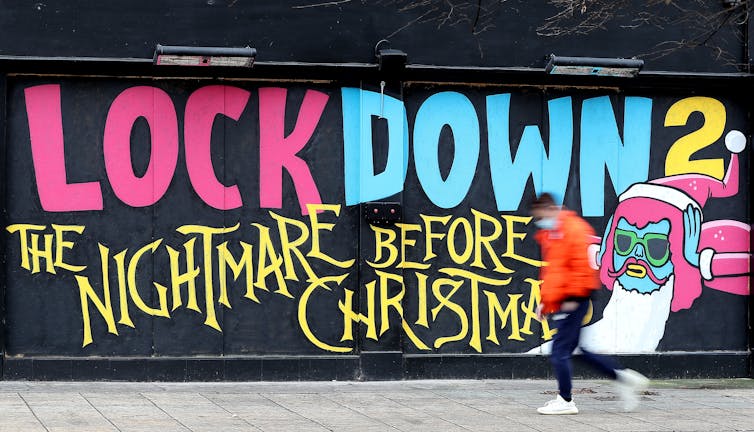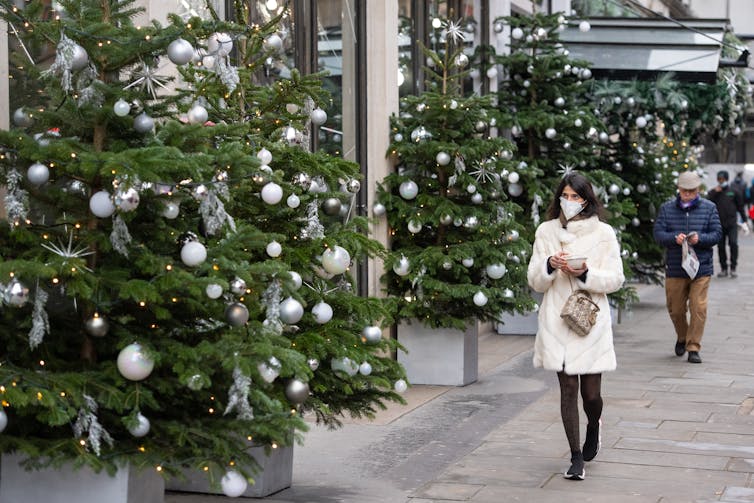This year, it’s safer to celebrate on Zoom. (Photo: Shutterstock)
In early November, the UK government put England into its second coronavirus lockdown. With rising infections nationally, strained health services and the threat of yet more deaths, the UK prime minister, Boris Johnson, said: “There is no alternative”.
An important factor in the decision to lock down in November was the hope that restrictions could be eased in time for Christmas. But even though the government has set out its plan for coming out of lockdown on December 2 and introduced a new tier system for that time, the conditions are not favourable. Indeed, many areas in England will be placed in tier 3 restrictions – the highest possible level – immediately.
Regardless of tier, between December 23 and 27, people in England will be able to form “bubbles” of three households who are permitted to gather over Christmas, mixing indoors and potentially staying overnight.
How to decide which tier is right
The government has had a difficult decision to make between controlling the spread of the virus and limiting the economic damage caused by restrictions. Lift restrictions too soon and you risk escalating infections in a matter of weeks that require the re-imposition of those restrictions. Indeed, government scientific advisers have warned that although tier 3 restrictions might slow the epidemic, they may not be enough to push it into decline.
When considering whether restrictions can be lifted for any given area, there are two key considerations. First, what are the epidemic trends? In epidemiological terms, this is summarised by the reproduction number, or R number, which gives an idea of whether onward transmission of the virus can be sustained in the longer term, and the lowercase r number, or growth rate, which indicates whether the epidemic is growing or shrinking. But infection trends are more complicated than just the R and r numbers.
We want to know not just how many new cases of infections are occurring, but also where they are happening, which age groups they are affecting and in which environments (such as workplaces, care homes or hospitals). If epidemic trends are consistently on the decline, this gives some reassurance that current measures are working and infections are being contained adequately. Unstable or rising trends, however, would be cause for concern as that tells us the situation is not fully under control.

The second consideration is the volume of infections – that is, just how many people are infected currently. Each infected person is a potential infector of someone else. So even if infection trends were on the decline, if there is a large pool of infected people out in the community, the likelihood of further spread is there, especially if restrictions are lifted and social mixing is allowed. To make matters worse, the epidemic will start from a high base and is likely to rise even further.
The other reason why the volume of infections matters has to do with the feasibility of containment. If the number of infections is low, health protection interventions such as mass testing are more likely to be able to contain the infections, as it would be easier for the teams involved to investigate most of the cases and manage outbreaks effectively. But when the volume of infections is high, this is likely to breach the capacity of even the most effective test and trace system.
We know that social mixing is what drives infections. And relaxing restrictions is likely to lead to a rebound in the number of social contacts that takes place. The more mixing that happens, the more opportunities there are for infections to spread. We also know from experience that many COVID-19 outbreaks can be traced to households.
Should you stay home for Christmas?
If December 25 held no cultural significance, it is highly likely that the current restrictions would not be eased as the conditions for doing so just aren’t there. However, in the UK and other western nations, this national holiday is an important part of the national psyche. The festive season is a time for families to congregate, usually in crowded homes, for prolonged periods. Unfortunately, these are the very conditions associated with infection transmission, which could lead to superspreader events.
The Christmas season is also associated with mass migration across a country that could increase disease transmission and could potentially transfer infections from areas of high incidence to low incidence communities. It involves the mixing of young and old, which carries the risk of transmission to elderly relatives who are more vulnerable to the serious consequences of the infection, including death.

Governments therefore need to consider what the cost of relaxing COVID-19 restrictions for Christmas might be. It is likely to drive up the number of infections, and in turn hospitalisation figures and mortality rates a few weeks later. It risks compromising countries’ containment of the epidemic, leading to further restrictions, and even additional lockdowns, weeks later. All of this would have serious societal and economic repercussions.
It is no exaggeration to say that the opportunity to meet friends and family on Christmas Day might mean having to bury the same people weeks later. With the promise of protection that vaccinations bring, the relaxation of restrictions for the holidays seems an unnecessary risk to take right now. Regardless of what tier system applies to your local area, it would be wise to stay within your own household for Christmas this year.
THE CONVERSATION

